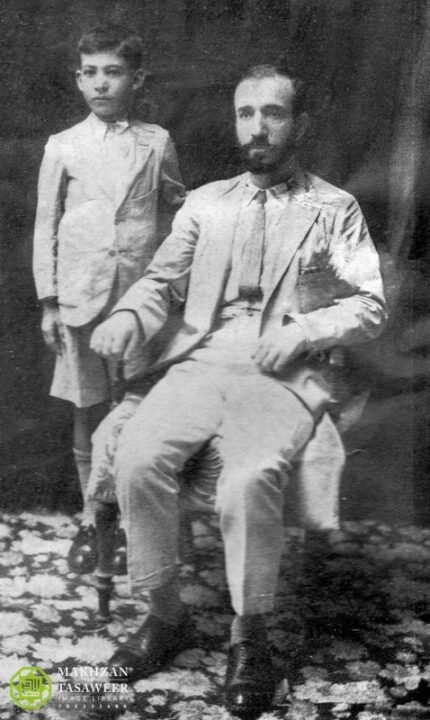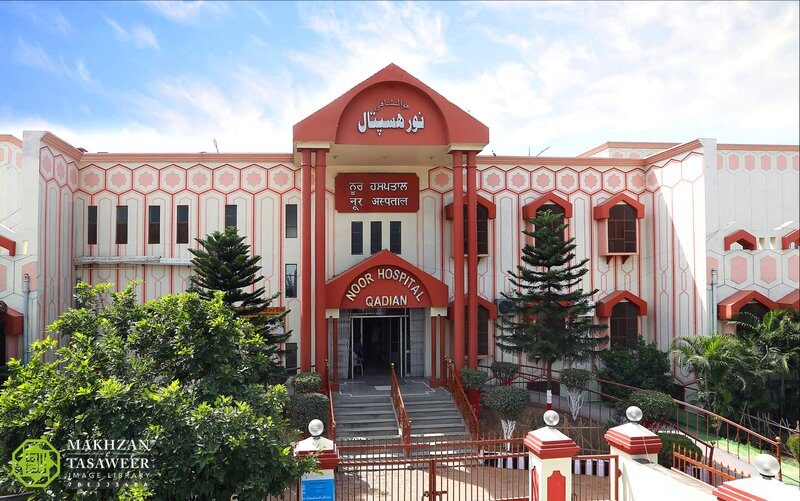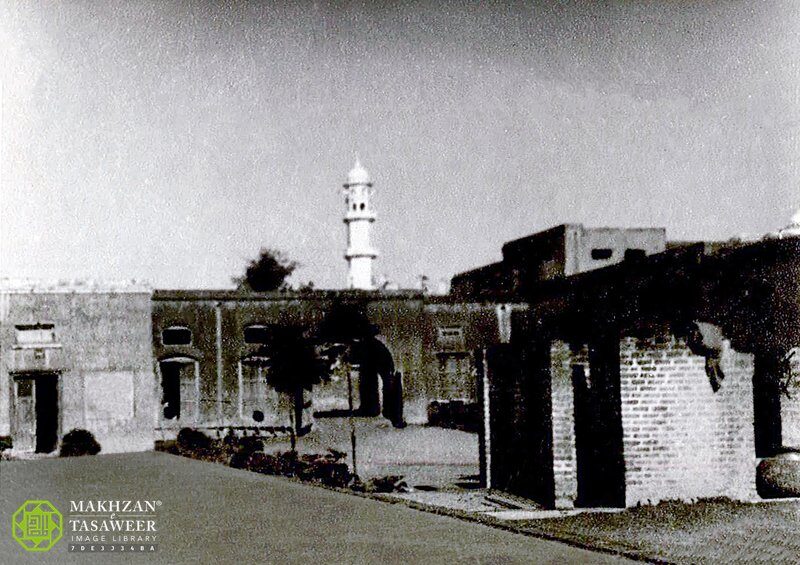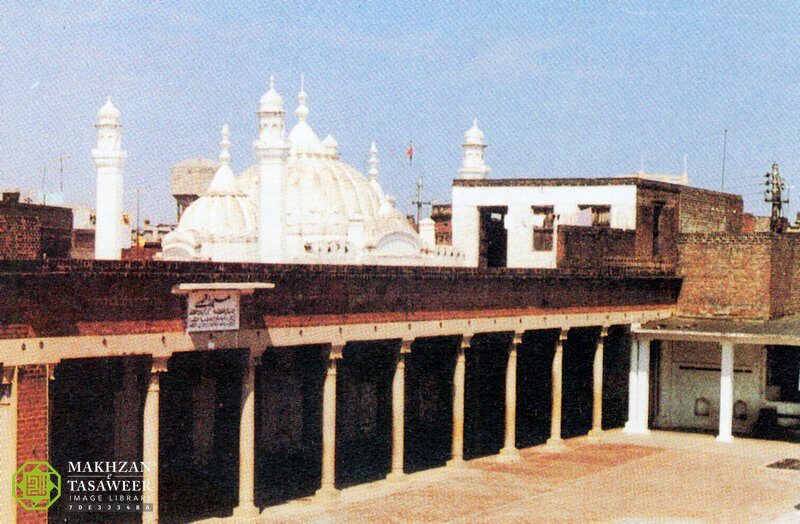A series looking at the high standard of morals of the Promised Messiahas and his Khulafa when receiving visitors in Qadian
Awwab Saad Hayat, Al Hakam

Abdullah R Scott was born in Glasgow, Scotland where he received his primary education. He converted to Islam in 1920 whilst serving in the Iraq Civil Telegraph Department. Later, in 1925, he accepted Islam Ahmadiyyat. Gifted with the ability to speak many languages, he was able to convert a few people to Islam Ahmadiyyat.
On 9 May 1931, he had the good fortune of visiting Qadian and meeting with Hazrat Musleh-e-Maudra.
Below are Abdullah R Scott’s impressions about Qadian which were published in The Review of Religions, issue 30, August 1931:
“My impressions of Qadian:
“By Abdullah R Scott
“Being the first British Ahmadi Muslim to visit Qadian, the birth-place of the Holy Founder of the Ahmadiyya Movement, (peace be on him), I feel it my duty to try and give my countrymen some idea of this holy place through this article.
“My arrival:
“After changing trains at the picturesque station of Batala, I arrived two hours later at the small but pretty station of Qadian with my son on the 9th May 1931.
“The station is about three-quarters of a mile from the town in a north-easterly direction. Just outside there were several tongas (sort of jaunting cars) standing. We were conveyed by one of these to the special guest house where our luggage was taken upstairs by the servants, and every effort was made to ensure our comfort.
“The guest house:
“The special guest house is a fairly large building with three rooms downstairs, two rooms upstairs, a bathroom and lavatory. About two hundred yards further along the road there is another guest house and behind this is a large kitchen and bakery. These are controlled by one of the secretaries to His Holiness, the Head of the Ahmadiyya Community, and his assistants. The former, now and again, makes a round of the guests enquiring whether they have any complaints about the food etc., and to see if any improvement can be made. They are always ready to serve you to the best of their abilities.
“Daily about three hundred men and women are entertained in the guest house. Also at the time of the Annual Gathering in December between 17,000 and 20,000 persons are provided with the board and lodge for a period of three to four days. Again, during the Easter holidays, delegate representatives from the different Ahmadiyya Anjumans all over the world attend the Ahmadiyya Conference to discuss the programme of work for the whole year and to consider the necessary items of the budget. The conference is purely representative. Like those of the Annual Gathering, these people also remain for a period of three to four days and the necessary arrangements are made [for] them.
“Besides these, orphans, widows and poor men are also maintained.
“The town of Qadian:
“The town of Qadian has an area of approximately two miles square with a population of over seven thousand.
“Although a few years ago it was only a small village, many houses have recently sprung up and are steadily increasing through outsiders taking up their abodes in the place where all their hearts and souls are centered. The houses are built of strong red bricks and cement and the main road is made of the same material. The inhabitants are very simple both in dress and food. They are also very hospitable and always cheery and courageous.
“In the Holy Quran, paradise is described as being a place wherein there will be no sorrow, fear, back-biting, quarrelling, etc. and everyone will greet each other with the words ‘As-salaamo-Alaikum’ (peace be on you). Here also in Qadian you find similar conditions prevailing. During the two months I have been here I have never seen or heard of anyone quarrelling, fighting or back-biting. Everyone greets each other with the greeting of ‘As-salamo-Alaikum’ (peace be on you).
“Besides the Ahmadis, there is also a goodly number of Sikhs and Hindus who carry on their religious rites without any sense of trouble from the Ahmadis whom they admit to be very peaceful and hospitable towards them even in these days of discord which is prevalent all over India between the Hindus and Muslims.
“Drinking intoxicants is a thing unheard of even amongst the non-Ahmadis of the town and cigarette smoking in public is non-existent.
“The people of Qadian, although of a religious turn of mind, are also very keen on gardening which requires an outlay of a good amount of money in this soil, and many gardens are to be found in this small town. Here you find the word and work of God working in conjunction with each other and not in opposition as the scientists would have us believe. In the northern parts of the town there is a fair-sized bazaar where many kinds of necessities are sold.
“Medical and sanitary arrangements:
“Considering the rapid growth of the town and financial difficulties, the sanitary arrangements, on the whole, are fairly good, although, of course, there is much room for improvement which will come in good time with the increase of the budget.
“There is a prophecy of the Promised Messiah (peace be upon him) that the town of Qadian would extend to the Biyas, a river twelve miles off from the town towards the east, and its gradual fulfilment is plainly visible.
“The roads are swept and the drains washed daily and all refuse taken away each morning in carts.
“A new slaughter-house has been built in order to cope with the increase of meat consumption. The Small Town committee manages all municipal affairs.
“There is a fairly large hospital known as the Noor Hospital (named after the first Khalifa-tul-Masih, Hazrat Hakeem Maulvi Noor-ud-Din Sahib – may God be please with him). It consists of one general ward, two private wards, operation room, laboratory, dressing room, consulting room and dispensary. There is also a nice garden and sturdy trees in the compound. Besides the people of Qadian, outsiders from the surrounding villages come here for treatment, including Sikhs and Hindus. The hospital is under the very able charge of Dr Hashmatullah Sahib and his very energetic and attentive staff.
“I had reason to personally experience the conditions prevailing in the hospital due to the fact that my son fell ill on the day after our arrival at Qadian. During his illness, he was given the best of attention, and Dr Hashmatullah Sahib treated him as he would have done his own son. He was given very costly medicines, and as the disease proved obstinate the medicines were changed from time to time and several other doctors were called in for the purpose of consultation as to the real diagnosis of my child’s illness. Eventually through the grace of Almighty God and the prayers of His Holiness Hazrat Khalifa-tul-Masih, my son recovered after a period of two months. The Doctor Sahib is an extraordinary, hard worker and takes the keenest interest in his patients. I have known him to attend sick persons at mid-day (after hospital hours) when the heat was stifling and himself not feeling well.

“Education:
“One of the many blessings of the Ahmadiyya Movement is the education of the masses, which was very badly needed, as the Muslims, although once the torch-bearers of knowledge, had sunk very low in ignorance due to the foolish ‘fatwas’ of the ulema. Not only in Qadian but in other parts of the world schools have been opened for both boys and girls by the Movement.
“Here, in Qadian, there are now four schools and two colleges, namely, Talim-ul-Islam High School, a fine large building with its site amongst gardens and protected on each side from the glare of the sun by rows of large shady trees. There is a large boarding house and mosque on its right for the use of the students among whom are to be found people from all parts of India, Afghanistan, Sumatra, Mauritius etc. Here secular education is given.
“Next is the Ahmadiyya School in which religious education is imparted, and instructions are given in Theology, Philosophy, Science and English.
“Thirdly, the Girls High School, and fourthly, the Primary School.
“Then there is the Ahmadiyya College where missionary work is taught and many missionaries are sent from here to all parts of the world who are doing splendid work propagating the truth of Islam.
“Lastly is the Girls’ College which has recently been opened by His Holiness Hazrat Khalifat-ul-Masih for the further advancement of female education.

“Posts and telegraph:
“The Post and Telegraph office is situated near the Masjid-i-Aqsa and has a busy time dealing with the large mail of the Ahmadiyya Community. They also have their share in spreading the truth of Ahmadiyyat, for, many important literature and correspondence pass through their office to and from all parts of the globe. Besides the Central Post Office, there is a branch office next to the Primary School. Each out-going and in-coming mail is dealt with very promptly.
“Places of worship:
“The small town of Qadian boasts of several mosques distributed throughout, each Mohalla (quarter) having its own mosque. The names of some of these are:
Masjid-i-Mubarik, Masjid-i-Aqsa, Masjid-i-Nur, Masjid Dar-ur-Rahmat and Masjid Dar-ul-Fazl. The first two are the more important ones. Masjid-i-Mubarik is attached to the house of the Promised Messiah (peace be on him). In this mosque more than hundred persons attend each of the five congregational prayers.
“Masjid-i-Aqsa is the largest mosque. It has a spacious courtyard and a magnificent minaret, known as Minarat-ul-Masih. This minaret commands a view of all the surrounding area, and can be seen from nine miles distance. It is divided in four portions viz., three balconies and a clock tower. The latter chimes the hours and the face of the clock can be seen from all four sides.
“The azan (call to prayer) is repeated five times daily from the topmost balcony. The minaret gives one the idea of a large torch being held aloft representing the truth of Islam and this appears more realistic at night when the clock tower is lit up. Masjid-i-Aqsa being the biggest mosque the Juma (Friday) prayer is conducted in it. Each week sees the mosque packed to overflowing. The women also attend the prayer in goodly numbers and are separated from the men by a wooden partition so that they can both hear the sermon and join the prayers.
“Mirza Ghulam Murtaza Sahib, the father of the Promised Messiah (peace be on him) lies buried in the yard of the mosque close to the Minarat-ul-Masih.

“His Holiness Khalifatul-Masih
“After my arrival at Qadian I was unable to see His Holiness for nearly a week due to the fact that he was out of town. The day after his return was a day of bad remembrance on which the late Qazi Mohammad Ali’s remains were brought to Qadian and, after His Holiness had conducted the burial ceremony, buried in the Bihishti-Muqbara. All these delayed my interview with His Holiness.
“However, three days after his return I was granted an interview and, I must admit, I felt rather nervous at the idea of meeting such a holy personage, but as soon as I entered the reception room His Holiness came forward with outstretched hand and a kindly smile, and his quiet beautiful voice dispelled all my qualms. He does not appear to feel the dignity of his rank and a village labourer is just as much at home in his company as any high official would be. His clothes are always very neat and spotlessly clean. He dresses very simply just like the ordinary dwellers of the town. When speaking to you he does not look at you with that piercing stare nor does he use that haughty tone which is generally the rule with men of high rank, but instead casts down his eyes only looking at you occasionally, and speaks in a very quiet manner. Even with his subordinates in the office his tone of speech never changes. Still, although he never uses the domineering methods which are often to be found in officialdom, all the work of the community goes on smoothly and no one dare go against his orders. He speaks English perfectly well.
“On Juma (Friday) His Holiness delivers the sermon and leads the prayer. When he enters the mosque the people stand up and many try to shake hands with him. Recently he was suffering with a very sore finger and although the hand-shaking caused him excruciating pain he never uttered a word of protest. Several papers are also handed to him in which he is requested to offer up prayers on behalf of the owners or their relatives. During the sermon the worshippers all seem spell bound as though being attracted by some powerful magnet, for, His Holiness is a wonderful and powerful speaker and delivers his sermons very clearly, distinctly and dauntlessly.
“Week-day prayers in the Masjid-i-Mubarik are also led by His Holiness and, on the most occasions, after prayers his followers crowd around him while he speaks to them on some religious subjects for about an hour or more.
“When he is not praying he is doing other works, such as, writing articles for the press, directing letters to correspondents etc. Private interviews are granted between the hours of eleven and twelve. At present His Holiness is writing notes on the Holy Quran which alone is a very strenuous work. He takes very little rest and, as far as I understand, has only about one and half to two hours out of twenty-four in private with his family. Night and day he exerts all his energy for the sake of Islam and always has the good of his community entirely at heart. All the members of the community absolutely adore him, even the non-Ahmadis including Hindus and Sikhs respect him very much and, as a matter of fact, one cannot help loving him.
“Organisation:
“All the work connected with the management of the movement is carried on by a number of Secretaries under the direction of His Holiness Hazrat Khalifatul Masih, Head of the Ahmadiyya Community. At present this has been arranged as follows:—
“(1) There is a Chief Secretary, who presides over cabinet meetings and supervises the work of the different Secretaries.
“(2) Secretary for Missionary Work is in charge of all the missionary activities of the movement and supervises the work of the different missions established in various parts of India and in other countries. He is also in a way Director of the Ahmadiyya Press and the Publishing Department.
“(3) Secretary for Education has charge of education, and religious and moral training of the community.
“(4) Home Secretary has charge of the social, economical, judicial, and other miscellaneous work of the movement.
“(5) Foreign Secretary has charge of the work connected with the relations of the community with the Government and other communities.
“(6) Secretary for Literary Department, whose duty it is to produce suitable literature, organises a central Ahmadiyya Library and carries on research work.
“(7) Secretary for Commerce.
“(8) Secretary for the Finance.
“(9) Secretary for dedicated property.
“(10) Besides, there is a Private Secretary to His Holiness the Khalifatul-Masih.
“Press:
“One weekly, one monthly (English), one tri-weekly, two weeklies, one monthly (Urdu) and one fortnightly for ladies (Urdu), are published from Qadian. Besides these, there are two quarterly magazines from the Ahmadiyya College and the TI School.
“Libraries:
“Qadian is the proud owner of five libraries including one for ladies. The largest of these is the Sadiq Library which contains a vast store of religious literature including all standard books on religious subjects. Dr SM Zwemer described these libraries as follows: ‘Shelves crowded with encyclopaedias, dictionaries, and anti-Christian philosophies – an armoury to prove the impossible.’ Without doubt it is an impregnable fortress that baffles the Christian missionaries.
“Condition of women:
A ladies’ central society known as the Lajna-i-Amaulla [sic] is established at the Headquarters for the general wel-fare of the Ahmadi ladies. Branches of this central Lajna are established in many other places. In spite of the true Islamic purdah being observed, a fairly large number of ladies have received education in both English and Oriental subjects and it is very surprising to learn that the percentage of literate ladies out-numbers that of the men.
“Co-operation with the Government:
“1. An Ahmadiyya Double Company in the Indian Territorial Force.
“2. A Criminal Tribes Agricultural Settlement.
“Services to the Government:
“1. About a thousand Ahmadis served in the Great War and some died on the battle field.
“2. A number of volunteers were placed at the disposal of the Government in the last Afghan War of 1919.
“3. Ahmadis rendered distinguished services in the troubled days of the Rowlatt Act, and Non-co-operation Movement disturbances.
“The funds:
“The funds are provided by public subscriptions, donations, and endowments and the income amounts to about six lakhs of rupees [600,000] yearly.
“Water supply:
“In Qadian only well-water is obtainable but water is good and plentiful and is very cool in summer when freshly drawn. These wells are also utilized for watering crops and gardens.
“Bahishti Muqbara:
“The original formation of the Bahishti-Muqbara (Grave-yard of Paradise) was due to a revelation received by the Promised Messiah (peace be on him). Accordingly a large piece of his own property, valued in those days at about Rs 1,000, was allotted to this purpose, and a committee was formed to manage all the affairs of income, expenditure etc. Only those persons who allot, at least, one-tenth of their incomes or do meritorious deeds in the cause of Ahmadiyyat are buried here. The main idea of this is to let future generations know what sacrifices the early Ahmadis made for the sake of their faith so that they also may be encouraged to do likewise.
“The Muqbara itself is situated to the south of the town in the midst of a large orchard of mango trees, Jammin trees, Pomegranate trees, Cyprus trees, Palms etc.
“The grave of the Promised Messiah (peace be on him) and that of his first successor are inside a compound enclosed by a red brick-wall with four doors facing north, south, east and west. Surrounding this compound lie buried the followers of the Promised Messiah (peace be on him). The graves are so uniformly laid out that they appear like regular rows of soldiers guarding their beloved master. Those in the very near vicinity of the compound are the early followers of the Holy Founder of Ahmadiyyat who accepted Bai‘at during his lifetime. The other graves are in close proximity leading-towards the south. Troops of purified souls on their onward march to the Great Goal. ‘O Soul that is at rest return to your Lord, well pleased (with Him) well pleasing (Him).’ Every grave has a tombstone with the name and year of death of the person buried written on it. These are similar in make and size.
“Who could have thought that the insignificant village of Qadian and that lonely person in, his place of solitude, whom very few knew or cared to know, would become the centre of attraction of the whole world and would flourish in so short a time? Yet all this was prophesied by the Promised Messiah (peace be on him) years before he pro-claimed the news of his advent and which alone is, in my humble opinion, a very strong argument in proof of his claim even if there had been no other sign.
“Let those seekers after truth who are not already acquainted with the full facts concerning the Ahmadiyya Movement and its Holy Founder, do so early, for, herein they will find unlimited treasures.” (Obtained from The Review of Religions, issue 30, August 1931, pp. 175-185)

